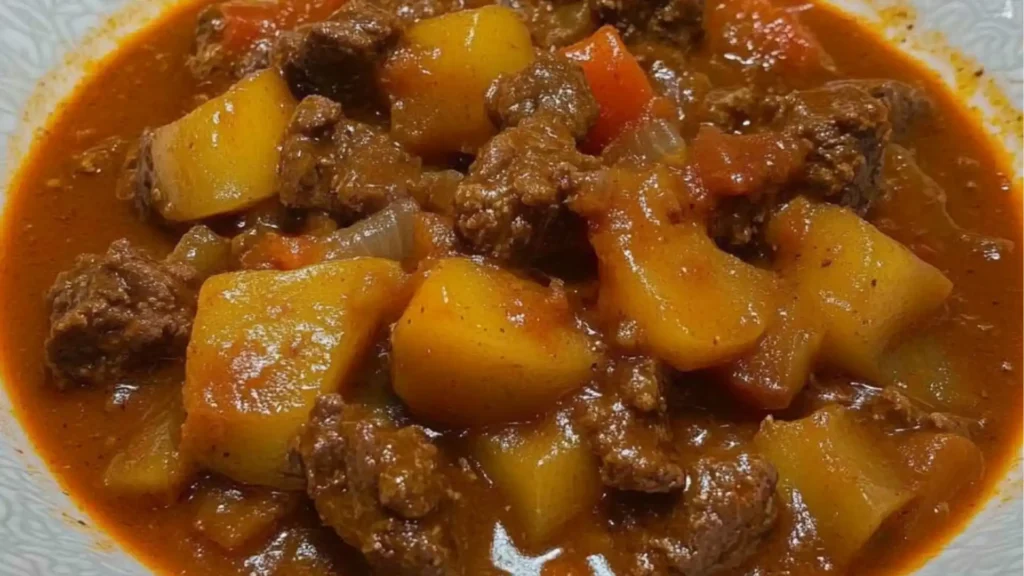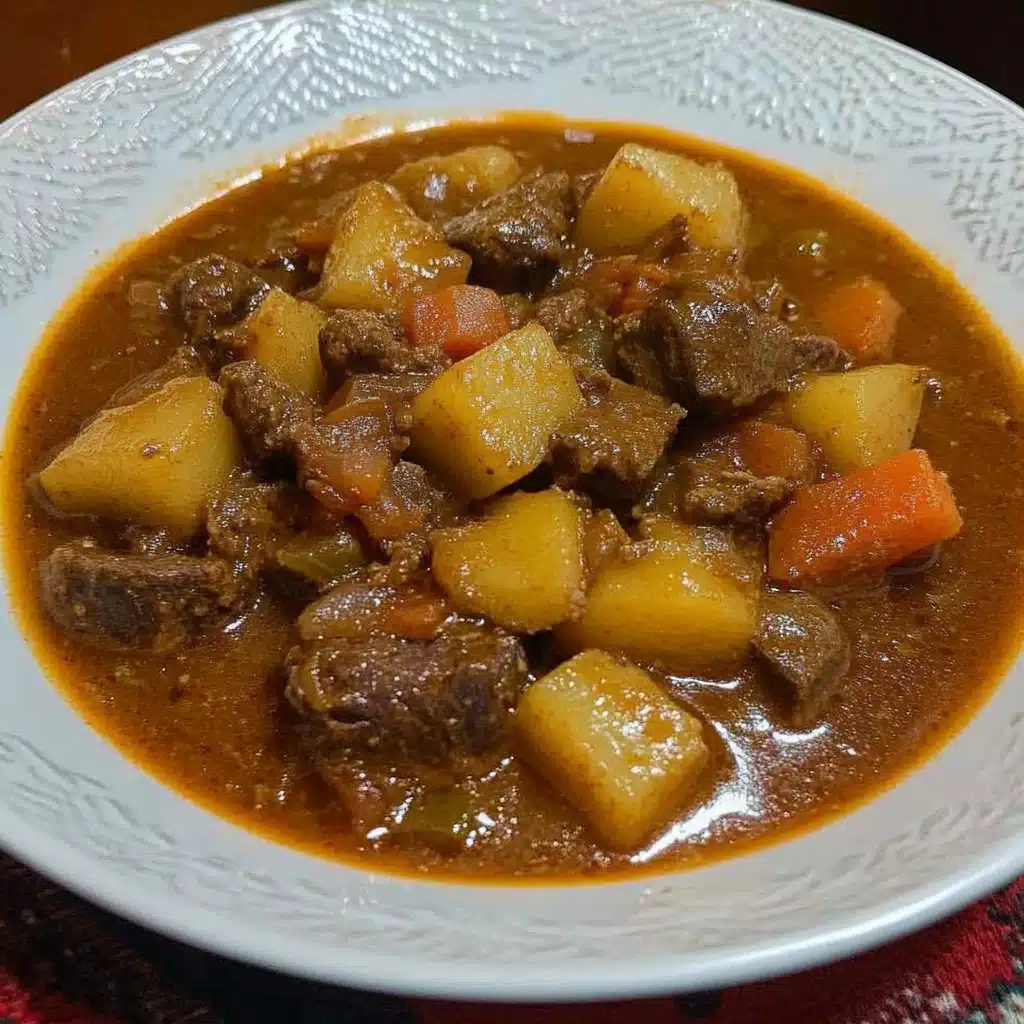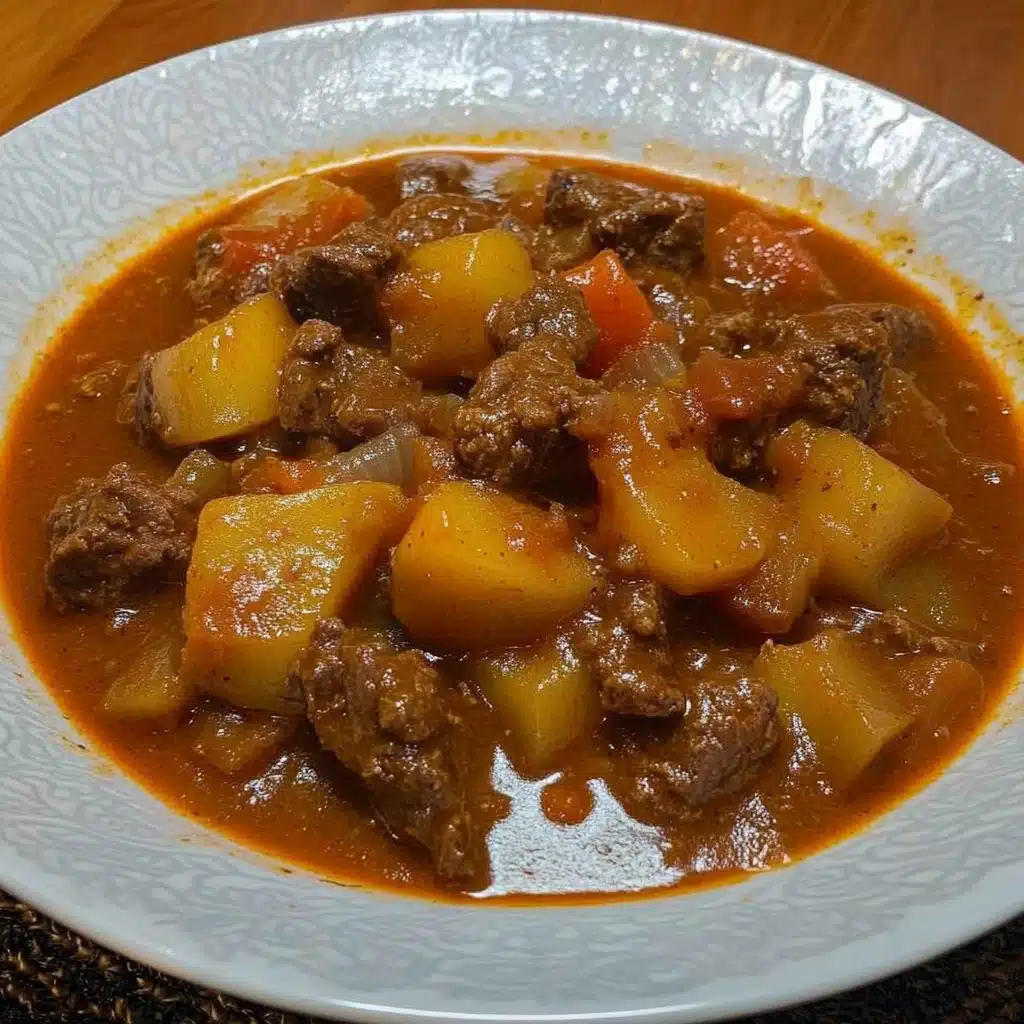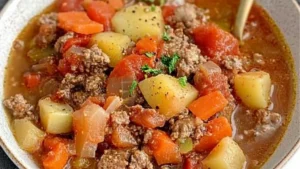Few dishes embody the warmth and flavor of African cuisine like Kenyan Beef Stew. Rich, aromatic, and deeply satisfying, this dish showcases tender chunks of beef simmered slowly in a flavorful tomato-based sauce, enhanced by spices, herbs, and colorful vegetables. It’s a true taste of Kenya — comforting, nourishing, and meant to be shared.
If you’ve ever wanted to experience authentic African beef stew recipes, this one is a perfect place to start. Simple ingredients, big flavors, and heartwarming tradition make it a dish every home cook should try.
Table of Contents
What is Kenyan Beef Stew?
Kenyan Beef Stew is a classic East African dish featuring slow-cooked beef combined with tomatoes, onions, and an assortment of vegetables. It’s usually served with Ugali, rice, or Chapati, making it a versatile staple in many Kenyan households.
Unlike Western stews that often rely on broth or wine, Kenyan stew builds flavor from fresh ingredients — sautéed onions, garlic, ginger, and spices like curry powder and paprika. The result is a fragrant, thick stew that’s both hearty and wholesome.
This dish also represents the foundation of traditional African beef stew, where simplicity and patience bring out the best in each ingredient.
The Heritage Behind Traditional African Stew with Meat and Vegetables
Across Africa, stews represent more than just meals — they’re a symbol of family, community, and heritage. In Kenya and Tanzania, beef stew is often served during family gatherings, Sunday lunches, and celebrations. The aroma of simmering stew wafting through the air evokes memories of home and togetherness.
In Kenya, a meal without stew feels incomplete. Whether it’s paired with Githeri, Chapati, or Ugali, beef stew forms the centerpiece of the dining table. Similar variations are found throughout Africa — Nigeria’s spicy tomato stews, Ghana’s palm-based stews, and Ethiopia’s Berbere-spiced versions.
Kenyan beef stew perfectly balances meat and vegetables, making it a wholesome and comforting representation of African recipes loved across the continent.
Kenyan Beef Stew Ingredients List (Exact Measurements)
To make the perfect Kenyan Beef Stew, gather the following ingredients (adapted from WeeAtAtLast.com):
Ingredients:
- 1½ pounds (700g) beef, cut into cubes
- 2 tablespoons vegetable oil
- 2 medium onions, chopped
- 3 cloves garlic, minced
- 1-inch piece of ginger, grated
- 3 ripe tomatoes, chopped
- 2 tablespoons tomato paste
- 1 teaspoon curry powder
- ½ teaspoon paprika
- ½ teaspoon turmeric
- 2 medium carrots, chopped
- 2 potatoes, peeled and diced
- 1 green bell pepper, sliced
- 1–2 cups (250–500ml) water or beef broth
- Salt and pepper to taste
- Fresh cilantro or parsley for garnish
Ingredient Tips:
- Use boneless beef chuck or stew meat for tenderness.
- For a richer flavor, add a splash of coconut milk or a dash of chili for heat.
- Vegetarians can substitute beef with mushrooms, beans, or tofu for a hearty plant-based alternative.
Essential Kitchen Tools You’ll Need
- Heavy-bottomed cooking pot or Dutch oven
- Wooden spoon
- Sharp knife and chopping board
- Measuring cups and spoons
- Mixing bowl
- Ladle or serving spoon
Using quality cookware helps evenly distribute heat, allowing your stew to simmer slowly and develop deep, rich flavor.
Step-by-Step Preparation Guide for the Perfect Kenyan Beef Stew
- Prepare the beef: Rinse and pat dry the beef cubes. Season lightly with salt and pepper.
- Brown the meat: Heat oil in a pot over medium-high heat. Add beef in batches and brown on all sides. This seals in the juices and adds depth to your stew.
- Sauté aromatics: Remove the browned beef and set aside. In the same pot, add chopped onions, garlic, and ginger. Sauté until fragrant and golden brown.
- Add tomatoes: Stir in chopped tomatoes and tomato paste. Cook until the tomatoes break down into a thick sauce.
- Season and simmer: Add curry powder, paprika, and turmeric. Stir well before returning the beef to the pot.
- Add vegetables: Mix in carrots, potatoes, and bell peppers. Pour in water or broth until ingredients are just covered.
- Simmer slowly: Reduce heat to low, cover, and let simmer for 45–60 minutes until beef is tender and sauce thickens. Stir occasionally to prevent sticking.
- Finish and serve: Adjust seasoning, garnish with chopped cilantro, and serve hot with your favorite side.
This step-by-step process ensures a flavorful Kenyan Beef Stew Recipe that’s rich in texture and taste.
How to Make Traditional African Beef Stew with Vegetables
The secret to an authentic African stew with meat and vegetables lies in layering flavors. Start by browning the beef for caramelization, then slowly build your base with onions, garlic, and tomatoes. Adding carrots, potatoes, and bell peppers provides sweetness, color, and body.
For a heartier version, try adding peas, green beans, or spinach toward the end of cooking. These vegetables not only add nutrients but also balance the rich, savory sauce.
For a delicious twist, pair your stew with Cheesy Mashed Potato Puffs or Garlic Herb Roasted Potatoes, Carrots and Zucchini from Lyndy’s Kitchen. They complement the dish beautifully while soaking up the flavorful sauce.
Common Mistakes to Avoid When Making Kenyan Stew
- Skipping the browning step: It’s crucial for flavor development.
- Using too much liquid: Stew should be thick, not soupy.
- Cooking on high heat: Slow simmering ensures tender meat.
- Adding all vegetables too early: Add firmer ones first and leafy greens later.
- Over-seasoning early: Let the flavors develop before adjusting salt and spices.
Serving Suggestions and Pairings for Kenyan Beef Stew
Kenyan Beef Stew pairs perfectly with several classic sides. Here’s how locals enjoy it:
- Ugali: A stiff maize flour dish that’s Kenya’s national staple.
- Chapati: Soft, layered flatbread perfect for scooping up stew.
- Rice or Pilau: Helps absorb the rich sauce and balance the spice.
- Mandazi: Sweet fried dough that contrasts the savory stew beautifully.
If you’re looking for variety, serve this stew with Pumpkin Twists or even Cottage Cheese Flatbread for a lighter accompaniment.
Recipe Variations Across Africa
- Tanzanian Beef Stew: Often cooked with coconut milk and mild curry spices for a creamy texture.
- Nigerian Beef Stew: Features bold heat from scotch bonnet peppers.
- Ethiopian Tibs: Stir-fried beef seasoned with Berbere spice.
- South African Tomato Bredie: Slow-cooked with tomatoes and potatoes for a comforting meal.
Each variation showcases the beauty and diversity of African beef stew recipes, unified by one theme: deep, soulful flavor.
Health Benefits and Nutrition Insights
Kenyan Beef Stew is packed with protein, iron, and vitamins from fresh vegetables. To make it healthier, trim excess fat from the beef and use moderate oil.
Adding more vegetables like spinach or peas boosts fiber and nutrients. You can use a nutrition calculator to track calories and macros based on your portion size.
This dish proves that traditional African cooking can be both hearty and wholesome when balanced with fresh ingredients.
Storage and Reheating Tips for Kenyan Beef Stew
- Refrigeration: Store leftovers in an airtight container for up to 4 days.
- Freezing: Freeze in meal-size portions for up to 3 months.
- Reheating: Warm gently on the stove over low heat or in a microwave-safe bowl. Add a splash of broth or water to refresh the sauce.
Kenyan Beef Stew often tastes even better the next day as the flavors continue to deepen overnight.
Kenyan Beef Stew Recipe Tips for Best Results
- Marinate beef with garlic, ginger, and spices for 30 minutes before cooking.
- Always brown meat for a deep, rich flavor.
- Simmer slowly to allow the sauce to thicken naturally.
- Add fresh herbs at the end for brightness.
- Serve hot with your favorite starch for a truly Kenyan experience.
For a satisfying dinner pairing, try it alongside Garlic Parmesan Chicken Skewers or a side of Scalloped Potatoes.
FAQs About African Beef Stew Recipes
1. Can I make Kenyan Beef Stew in a slow cooker?
Yes! Brown the beef first, then transfer everything to a slow cooker. Cook on low for 6–8 hours.
2. What’s the best cut of meat for stew?
Beef chuck, shoulder, or brisket — cuts that become tender with slow cooking.
3. Can I make it spicy?
Absolutely! Add chili flakes, cayenne pepper, or a diced green chili.
4. Can I freeze Kenyan Beef Stew?
Yes, it freezes perfectly for meal prep or quick dinners.
5. What’s the secret to rich flavor?
Patience. Allow time for the beef to brown and the sauce to reduce naturally.
Final Thoughts and Call to Action
The Kenyan Beef Stew Recipe is more than just food — it’s a piece of Africa’s culinary soul. Each bite captures the warmth, history, and comfort of traditional cooking passed down through generations. Whether enjoyed in a Nairobi home or a kitchen halfway across the world, it brings people together with every spoonful.
Try this Traditional African Beef Stew with Meat and Vegetables today and experience the flavors that make Kenya’s cuisine so special. Pair it with Chapati, Ugali, or even a side of Cheesy Zucchini Bread for a wholesome, heartwarming meal.
If you enjoyed this recipe, share it with your friends and subscribe to our blog for more authentic African recipes that bring the continent’s vibrant flavors to your table.
PrintKenyan Beef Stew Recipe – A Hearty African Classic Full of Flavor
- Total Time: 1 hour 15 minutes
- Yield: 6 servings 1x
Description
Rich, savory, and deeply comforting, this Kenyan Beef Stew Recipe features tender beef simmered with tomatoes, onions, and aromatic spices. A traditional East African favorite perfect with Ugali, Chapati, or rice.
Ingredients
- 1 ½ pounds (700 g) beef, cubed (chuck or brisket)
- 3 tablespoons vegetable oil
- 1 large onion, finely chopped
- 3 tomatoes, diced
- 3 cloves garlic, minced
- 1-inch piece of ginger, grated
- 2 medium carrots, chopped
- 2 potatoes, peeled and cubed
- 1 green bell pepper, diced
- 2 tablespoons tomato paste
- 1 teaspoon paprika
- 1 teaspoon curry powder
- ½ teaspoon turmeric
- ½ teaspoon black pepper
- 1 teaspoon salt (to taste)
- 2 cups beef stock or water
- Fresh cilantro for garnish
Instructions
- Brown the beef: Heat oil in a large pot. Add beef cubes and sear until browned on all sides.
- Add aromatics: Stir in onions and cook until golden. Add garlic and ginger, sauté for 30 seconds.
- Incorporate tomatoes: Add diced tomatoes and tomato paste. Cook until tomatoes soften into a thick sauce.
- Season: Add paprika, curry powder, turmeric, salt, and pepper. Stir well.
- Add vegetables: Toss in carrots, potatoes, and bell pepper. Mix everything to coat with the spices.
- Simmer: Pour in beef stock or water to cover the meat. Bring to a boil, then reduce heat and simmer for 45–60 minutes until the beef is tender and sauce thickens.
- Finish: Adjust seasoning to taste and garnish with fresh cilantro before serving.
Notes
- Use chuck or shoulder beef for best texture after simmering.
- Brown meat in batches to avoid steaming.
- Simmer slowly for rich, developed flavor.
- Add coconut milk for a creamy Coastal Kenyan variation.
- Serve with Ugali, Chapati, or steamed rice for a complete meal.
- Prep Time: 15 minutes
- Cook Time: 60 minutes
- Category: Main Course
- Method: Stovetop
- Cuisine: Kenyan
Nutrition
- Serving Size: 1 bowl
- Calories: 320
- Fat: 15
- Carbohydrates: 18
- Fiber: 3
- Protein: 27
Keywords: Kenyan Beef Stew, African Beef Stew, nyama na mchuzi, traditional Kenyan recipes, East African stew







